Fairborn, Ohio facts for kids
Quick facts for kids
Fairborn, Ohio
|
||
|---|---|---|
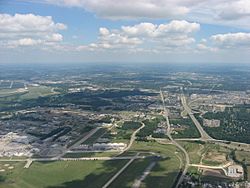
Aerial view of Fairborn
|
||
|
||
| Motto(s):
"A City in Motion"
|
||
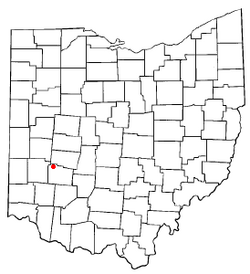
Location of Fairborn, Ohio
|
||
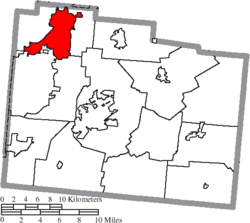
Location of Fairborn in Greene County
|
||
| Country | United States | |
| State | Ohio | |
| County | Greene | |
| Incorporated | 1950 | |
| Area | ||
| • Total | 14.58 sq mi (37.77 km2) | |
| • Land | 14.57 sq mi (37.74 km2) | |
| • Water | 0.01 sq mi (0.03 km2) | |
| Elevation | 837 ft (255 m) | |
| Population
(2010)
|
||
| • Total | 32,770 | |
| • Estimate
(2019)
|
33,876 | |
| • Density | 2,325.05/sq mi (897.70/km2) | |
| Time zone | UTC-5 (Eastern (EST)) | |
| • Summer (DST) | UTC-4 (Eastern (EDT)) | |
| ZIP code |
45324
|
|
| Area code(s) | 937, 326 | |
| FIPS code | 39-25914 | |
| GNIS feature ID | 1077584 | |
| Website | https://www.fairbornoh.gov | |
Fairborn is a city in Greene County, Ohio, United States. The population was 32,770 at the 2010 census. Fairborn is a suburb of Dayton, and part of the Dayton Metropolitan Statistical Area.
It is the only city in the world named Fairborn, a portmanteau created from the names Fairfield and Osborn. After the Great Dayton Flood of 1913, the region and state created a conservation district here and, in the 1920s, began building Huffman Dam to control the Mad River. Residents of Osborn were moved with their houses to an area alongside Fairfield. In 1950, the two villages merged into the new city of Fairborn.
The city is home to Wright State University, which serves nearly 12,000 undergraduate and graduate students. The city also hosts the disaster training facility known informally as Calamityville.
History
Fairborn was formed from the union of the two villages of Fairfield and Osborn. Fairfield was founded in 1816 and Osborn in 1850.
Before European settlers arrived, native inhabitants of the region included the Adena culture of Ohio and nearby states, and the subsequent Hopewell culture known from Illinois to Ohio and renowned for their geometric earthworks. Several surviving examples of earthen mounds made by Mound builders still exist at the Wright Brother's Memorial atop the bluff overlooking Huffman Prairie, and another lies on the grounds of the base.
The area of the village of Fairfield was settled before Ohio was a state. The first log cabin was built by George Greiner in 1799. The area where the village would grow was favorable to pioneers who were moving northward and westward from Kentucky and Virginia. Often there were raids made upon the settlement by local Indians, followed by similar raids on local native settlements. Although no massacres took place, both sides engaged in taking prisoners. There are two accounts regarding the name "Fairfield". One more accepted account claims that a local Native American - possibly a Shawnee - tribal chief, in speaking to one of the town's leaders after making peace and exchanging prisoners, said to William Cozad that when he looked out from Reed's Hill over the town,
Yonder lies a fair field. I see thousands of white men moving about in that beautiful fair field.
The other possible source for the name is after a Fairfield in England.
Osborn was a town (no longer existing) located near the Haddix Road-Ohio 235 intersection at the northern edge of Wright-Patterson Air Force Base in what is now the flood-prone basin of the Huffman Dam in the U.S. state of Ohio. Osborn was named after the superintendent of the railroad named E.F. Osborn. The previously unnamed town allowed the railroad to be built through it after the nearby town of Fairfield refused the plan of the railway to go through there. Many of the original houses of old Osborn still stand in Fairborn's Historic Osborn District.
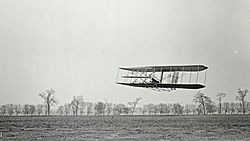
Huffman Prairie, part of Dayton Aviation Heritage National Historical Park, is an 84-acre (.34 km²) patch of rough pasture that was outside the village of Fairfield (now known as Huffman Prairie Flying Field), where the Wright Brothers undertook the difficult and sometimes dangerous task of creating a dependable, fully controllable airplane and training themselves to be pilots. After they began making use of Huffman Prairie in 1904, the Wright brothers made hundreds of flights here after developing the 1905 Wright Flyer III (the plane they considered to be the first practical airplane), testing the aircraft built by the Wright Company. At the Wright Flying School, also located here, they trained more than a hundred pilots, including the flyers for the Wright Exhibition Team and the first military flyers, including Henry H. Arnold and Thomas DeWitt Milling. The United States Army Signal Corps purchased the field in 1917 and renamed it, along with 2,000 acres (8.1 km2) adjacent (8 km²), Wilbur Wright Field. In 1948 the area was merged with nearby Patterson Field and became Wright-Patterson Air Force Base.
In 1921 nearly the entire town of Osborn, along with the railroad (now Norfolk Southern Railway), were relocated two miles away during construction of the Huffman Dam on the Mad River to a site east of and adjacent to Fairfield. This was necessary because of the Miami Valley Flood Control Project and the Miami Conservancy District that was begun after the Great Dayton Flood (Dayton, Ohio) of March, 1913. The village decided to move homes out of the flood plain on flatbed trucks and settle alongside Fairfield.
Growth of the two villages was hindered by the other's borders, a military flying field and depot (now Wright-Patterson Air Force Base), township borders, and county borders. The two villages voted to merge in 1949 and officially merged in 1950 The first business to depict the name of the new city was the large vertical sign of the Fairborn Theatre.
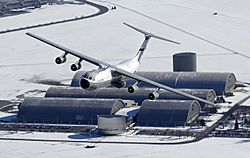
From 1950-1970 the city experienced explosive growth to six times its former population, surpassing Xenia (the county seat) as the most populous city in the county, due largely to the local employment opportunities made available by the nearby Air Force Base. Another employer, Southwestern Portland Cement, operated the largest factory in the city during this period, mining the locally exposed Brassfield Formation.
The development of Interstate 675 (Ohio) began in the 1960s to serve as an eastern bypass of Dayton. In the early 1970s, construction began on the northernmost part of I-675, just east of Fairborn. The first segment terminated at N. Fairfield Road (exit 17). No further construction was done for over a decade and it was jokingly referred to by some as "Fairborn's private Interstate". Dayton Mayor James H. McGee opposed the highway, contending it would draw economic development out of the city into the suburbs. I-675 was eventually completed by 1987.
Fairborn's growth slowed significantly in the 1970s and has only resumed at a moderate pace since the late 1980s. It has since been surpassed by neighboring Beavercreek, Ohio in population.
In local history,The Fairborn Agreement, a peace accord between the parties to the hostilities of the conflict in Bosnia-Herzegovina and the former Yugoslavia, was negotiated at Wright-Patterson Air Force Base. Negotiations took place from November 1, 1995, to November 21, 1995, at Wright-Patterson Air Force Base located next to Fairborn, Ohio.
As of 2007, Fairborn is a quiet town with many still working at the nearby Wright Patterson Air Force Base, the home of the Air Force Materiel Command and in many measures the largest, most diverse and organizationally complex base in the Air Force.
Many also work at or attend Wright State University, a university that became independent in 1967. From a small cluster of buildings it has grown into a major campus with almost 20,000 students. Though Wright State has a Dayton, Ohio address it is legally within Fairborn jurisdiction and has police officers deputized by the Fairborn police department.
Fairborn is the home of the largest elementary school in Ohio, Fairborn Primary School. Downtown Fairborn's historic Foy's store has the state's largest collection of Halloween supplies.
Fairborn hosts its annual Sweet Corn Festival every August and the USAF marathon every September. It also prides itself on its annual 4th of July Parade. Fairborn is also home of the Fairborn Wee Hawks Pee Wee Football teams. [1]
Geography
Fairborn is located at 39°48′28″N 84°1′19″W / 39.80778°N 84.02194°W.
According to the United States Census Bureau, the city has a total area of 13.17 square miles (34.11 km2), of which, 13.16 square miles (34.08 km2) is land and 0.01 square miles (0.03 km2) is water.
Demographics
| Historical population | |||
|---|---|---|---|
| Census | Pop. | %± | |
| 1950 | 7,847 | — | |
| 1960 | 19,453 | 147.9% | |
| 1970 | 32,267 | 65.9% | |
| 1980 | 29,747 | −7.8% | |
| 1990 | 31,300 | 5.2% | |
| 2000 | 32,052 | 2.4% | |
| 2010 | 32,770 | 2.2% | |
| 2019 (est.) | 33,876 | 3.4% | |
| Sources: | |||
2010 census
As of the census of 2010, there were 32,770 people, 14,306 households, and 7,995 families residing in the city. The population density was 2,458.4 inhabitants per square mile (949.2/km2). There were 15,893 housing units at an average density of 1,207.7 per square mile (466.3/km2). The racial makeup of the city was 84.8% White, 7.7% African American, 0.3% Native American, 3.1% Asian, 0.1% Pacific Islander, 0.8% from other races, and 3.1% from two or more races. Hispanic or Latino people of any race were 2.4% of the population.
There were 14,306 households, of which 26.3% had children under the age of 18 living with them, 36.7% were married couples living together, 14.4% had a female householder with no husband present, 4.8% had a male householder with no wife present, and 44.1% were non-families. 32.7% of all households were made up of individuals, and 8.8% had someone living alone who was 65 years of age or older. The average household size was 2.24 and the average family size was 2.85.
The median age in the city was 32.4 years. 20.4% of residents were under the age of 18; 16.7% were between the ages of 18 and 24; 26.3% were from 25 to 44; 23.4% were from 45 to 64; and 13.2% were 65 years of age or older. The gender makeup of the city was 48.9% male and 51.1% female.
Education
- Fairborn Primary School (formerly 5 Points Elementary School), grades pre-K-3
- Fairborn Intermediate School (formerly Palmer-South), grades 4–5
- Fairborn Baker Middle School (formerly Fairborn Baker High School), grades 6–8
- Fairborn High School (formerly Park Hills High School), grades 9–12
- Wright State University, a public university with over 19,000 students
Fairborn is served by a branch of the Greene County Public Library.
Notable people
- Brian Billick, head coach of the Baltimore Ravens, 1999–2007
- Roger B. Chaffee, astronaut who died in the Apollo 1 fire
- Kevin DeWine, Ohio Representative to the 70th district; Speaker Pro Tempore of the Ohio House of Representatives
- Gus Grissom, astronaut who died in the Apollo 1 fire
- J. D. Harmeyer, entertainment figure who appears on Howard Stern Show
- Colonel Gregory H. Johnson, NASA astronaut
- Gary A. Klein, pioneer in the field of naturalistic decision
- Martha Masters, classical guitarist
- Buddy Miller, roots musician, singer-songwriter, and producer, member of Emmylou Harris's Spyboy Band
- Roger Osborne, author
- Michael J. Saylor, founder of MicroStrategy
- Mark Turner, jazz saxophonist and teacher at the Manhattan School of Music
- Jackie (Waddell) Warner, actress in the reality television series Work Out
See also
 In Spanish: Fairborn (Ohio) para niños
In Spanish: Fairborn (Ohio) para niños


